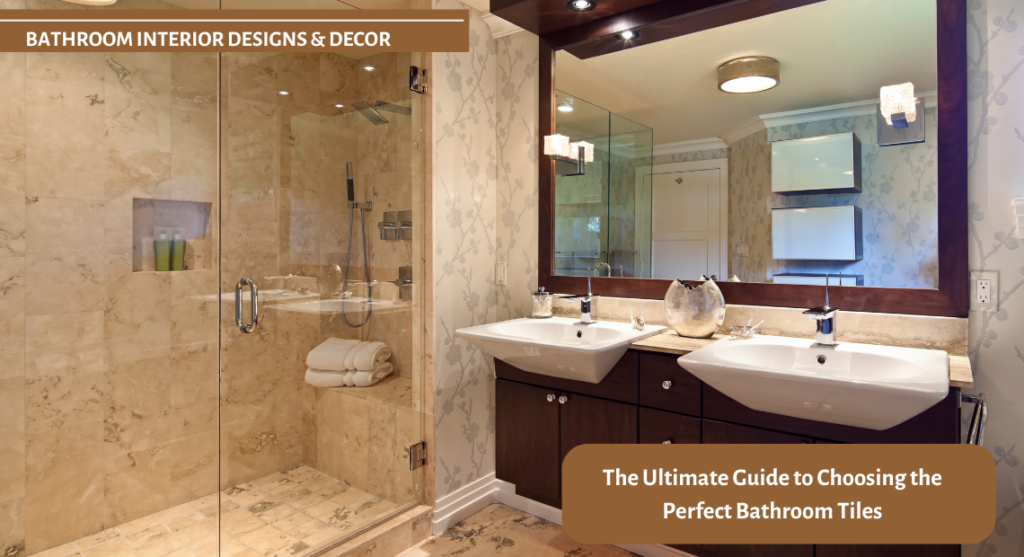When it comes to designing or remodeling a bathroom, one of the most important decisions you’ll make is selecting the right tiles. Bathroom tiles set the tone for the entire space, combining functionality with aesthetic appeal. Whether you’re renovating a small powder room or creating a luxurious spa-like retreat, the right tile choice can elevate the look and feel of your bathroom.
In this comprehensive guide, we’ll walk you through everything you need to know about choosing the perfect bathroom tiles, from the various types and materials available to tips on color, size, layout, and maintenance.
1. Understand the Types of Bathroom Tiles
Tiles come in a wide range of materials, sizes, shapes, and finishes, each with its unique benefits. Let’s break down some of the most popular types of tiles for bathrooms:
Ceramic Tiles
Ceramic tiles are one of the most common and affordable choices for bathrooms. They’re made from clay, fired at high temperatures, and glazed to create a durable, moisture-resistant surface. Ceramic tiles are easy to clean and come in a variety of shapes, sizes, and colors, making them a versatile option for any bathroom style.
- Best for: Walls, floors, showers, and backsplashes
- Advantages: Affordable, wide variety of designs, easy to clean, durable
Porcelain Tiles
Porcelain tiles are a subtype of ceramic tiles but are made from a denser, less porous clay. This makes them even more durable and water-resistant than regular ceramic tiles, making them ideal for high-moisture environments like bathrooms.
- Best for: Floors, walls, showers, and even wet areas
- Advantages: Extremely durable, water-resistant, low maintenance
Natural Stone Tiles
Natural stone tiles, such as marble, granite, travertine, slate, and limestone, can add a touch of luxury and sophistication to your bathroom. Stone tiles are known for their unique, natural patterns and textures. However, they may require more maintenance compared to ceramic and porcelain tiles, as some types are more porous and prone to staining.
- Best for: Floors, walls, and accents
- Advantages: Timeless elegance, unique patterns, durable (varies by stone type)
- Considerations: Higher maintenance (sealing required), expensive
Glass Tiles
Glass tiles are an excellent choice for creating a sleek, modern look. They reflect light, making small spaces feel larger and brighter. These tiles are often used for backsplashes or accent walls and can be combined with other tile types for added dimension.
- Best for: Backsplashes, shower accents, and decorative walls
- Advantages: Reflects light, easy to clean, visually stunning
- Considerations: Can be slippery when used on floors, may show water spots
Mosaic Tiles
Mosaic tiles are small tiles (usually less than 2 inches in size) arranged in intricate patterns. They can be made from ceramic, glass, or natural stone, and are often used as accents or to create detailed, eye-catching designs. Mosaics are perfect for adding a pop of color or texture to your bathroom.
- Best for: Shower walls, backsplashes, accent areas, and floors
- Advantages: Customizable designs, variety of materials, ideal for creating a focal point
- Considerations: More grout lines to clean, can be time-consuming to install
2. Consider Tile Size and Layout
The size of your tiles can dramatically affect the overall look and feel of your bathroom. Here are some tips on choosing the right size and layout:
Tile Size
- Small Tiles: Smaller tiles (like 2×2 or 3×3 inch mosaics) are perfect for creating detailed patterns or fitting into tight spaces. They’re ideal for shower floors or intricate backsplash designs. However, they can make a space feel more cluttered if used on larger surfaces.
- Large Tiles: Larger tiles (like 12×12 inches or 24×24 inches) create a sleek, modern look and work well in larger bathrooms. They have fewer grout lines, making them easier to clean and giving a clean, minimalist aesthetic. Keep in mind that large tiles may make small spaces feel even more cramped.
Tile Layout
- Straight Lay: The most common and simple layout, where tiles are arranged in straight rows.
- Herringbone: A trendy pattern where tiles are arranged in a zigzag formation. It adds visual interest and sophistication, especially in smaller bathrooms.
- Diagonal: Laying tiles at a 45-degree angle creates a more dynamic and visually interesting look. It’s particularly effective for small spaces.
- Brick or Offset: Tiles are staggered, like bricks in a wall, which works well with rectangular tiles.
3. Choosing the Right Color and Style
The color and style of your bathroom tiles should complement the overall theme and mood of your space. Here are some tips:
Neutral Colors
- Neutral shades like white, gray, beige, or taupe are timeless and versatile. These colors work well in almost any bathroom style, from traditional to modern. Light-colored tiles can make small bathrooms appear larger and more open.
Bold Colors
- If you want to add a touch of personality and flair, bold colors like navy blue, emerald green, or even black can create a striking contrast. Bold tiles can be used for accent walls or as part of a larger tile design to add a pop of color.
Patterns and Textures
- If you’re looking to create visual interest, consider tiles with patterns, textures, or 3D elements. Subway tiles, patterned encaustic tiles, or tiles with a matte finish can all help to break up monotony and add character to your bathroom.
Accent Tiles
- To add extra visual interest, you can mix and match different tile materials or colors. For example, a neutral tile floor can be paired with a bold mosaic backsplash or a colorful accent strip in the shower. This allows you to incorporate your personal style without overwhelming the space
4. Functionality and Safety
While aesthetics are important, don’t forget about functionality and safety when choosing bathroom tiles. Bathrooms can get slippery when wet, so selecting the right tile finish is crucial for preventing accidents.
Slip Resistance
- Look for tiles with slip-resistant ratings (often indicated by the Coefficient of Friction or COF rating) for bathroom floors, especially in areas that will be exposed to water. Textured tiles, matte finishes, and porcelain tiles are good choices for slip resistance.
Water Resistance
- Bathrooms are constantly exposed to moisture, so it’s essential to choose tiles that are moisture-resistant. Porcelain tiles, glass tiles, and glazed ceramic tiles are excellent choices for wet areas, like the shower and around the bathtub.
Grout Considerations
- Grout is essential for keeping tiles in place and ensuring a watertight seal. Choose a grout color that complements your tiles but also blends seamlessly into the design. Keep in mind that darker grout is better for hiding dirt, while lighter grout shows fewer water stains.
5. Tile Maintenance and Durability
Different tile materials require varying levels of maintenance, so consider how much time you’re willing to dedicate to upkeep.
- Ceramic and Porcelain Tiles are easy to maintain and require little more than regular cleaning with mild detergent.
- Natural Stone Tiles like marble or travertine need to be sealed periodically to prevent staining and water damage.
- Glass Tiles are easy to clean, but you may need to wipe away water spots and soap scum more frequently.
In general, choosing a durable material for high-traffic areas like bathroom floors is crucial for long-term performance.
6. Budgeting for Bathroom Tiles
- Tile prices can vary significantly depending on the material, size, and brand. Natural stone tiles tend to be more expensive, while ceramic and porcelain tiles are more budget-friendly. When budgeting for your bathroom renovation, factor in the costs for tile installation, grout, sealants, and any professional help you may need.
Choosing the perfect bathroom tiles is a combination of style, function, and practicality. By understanding the different types of tiles, their materials, and their benefits, you can make an informed decision that reflects your personal style and fits your bathroom’s needs. Whether you’re going for a minimalist look with large porcelain tiles or creating a bold, colorful statement with mosaic glass, the right tiles will transform your bathroom into a beautiful and functional space.


